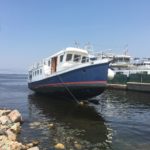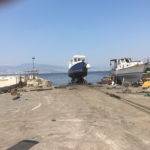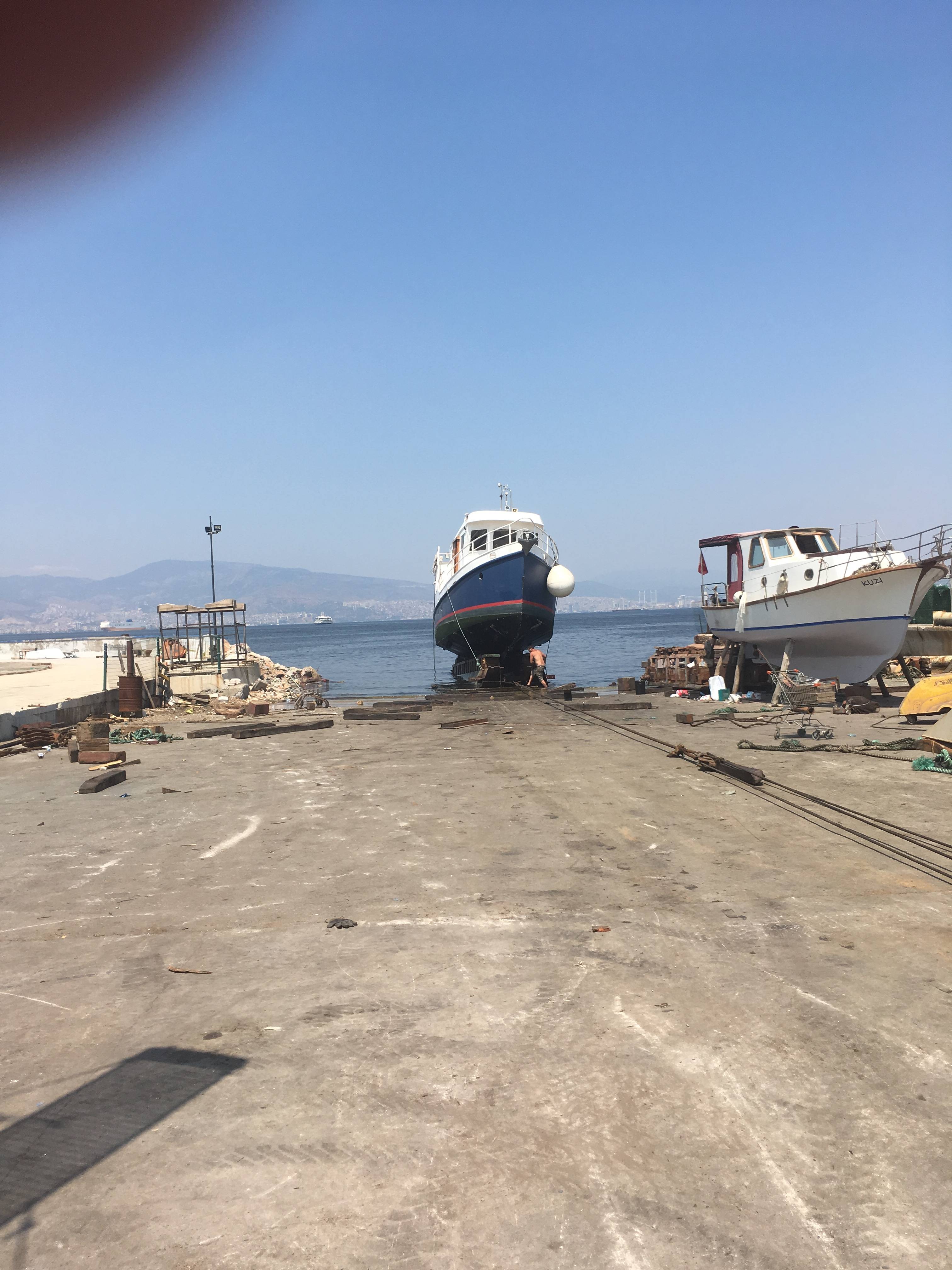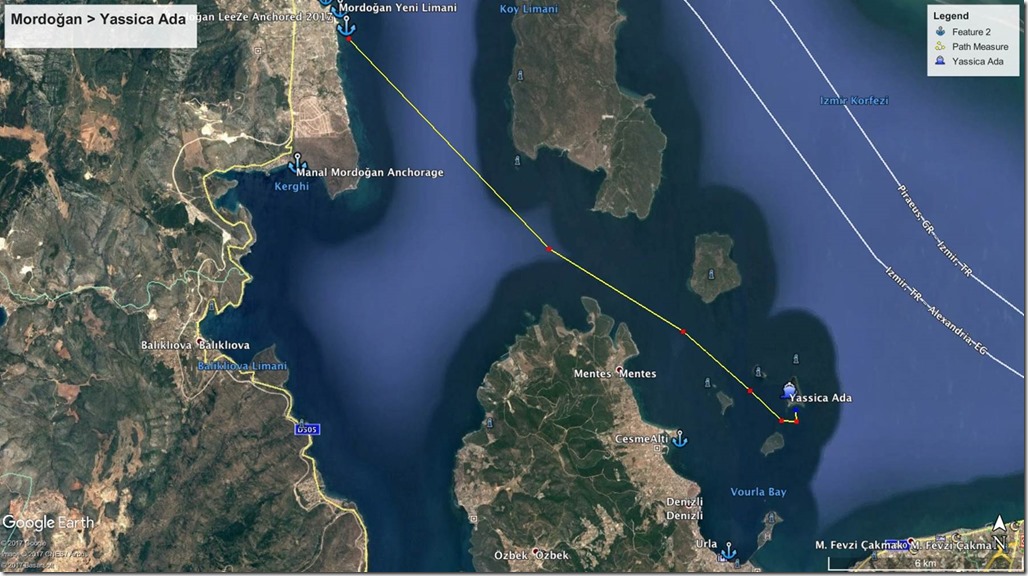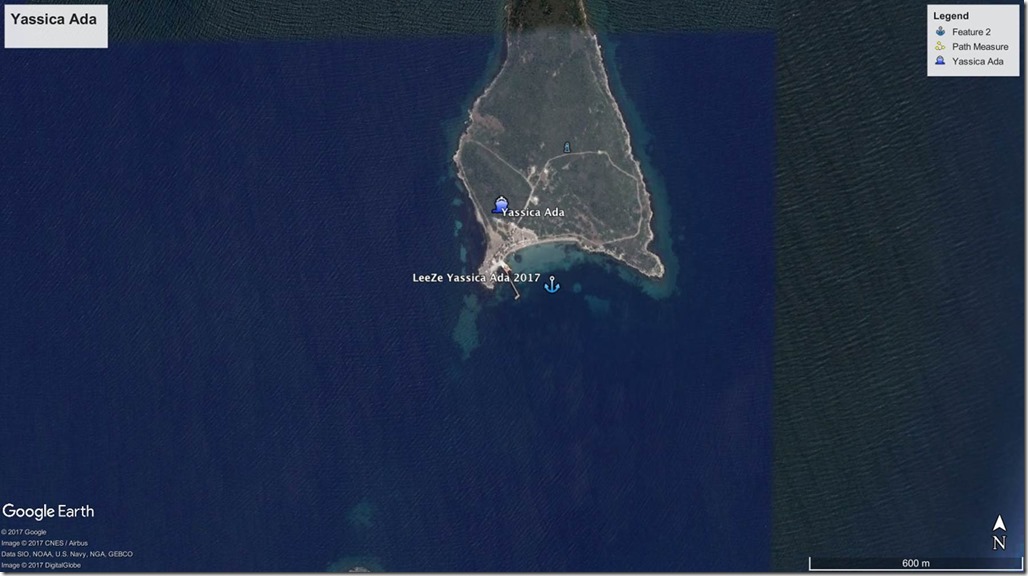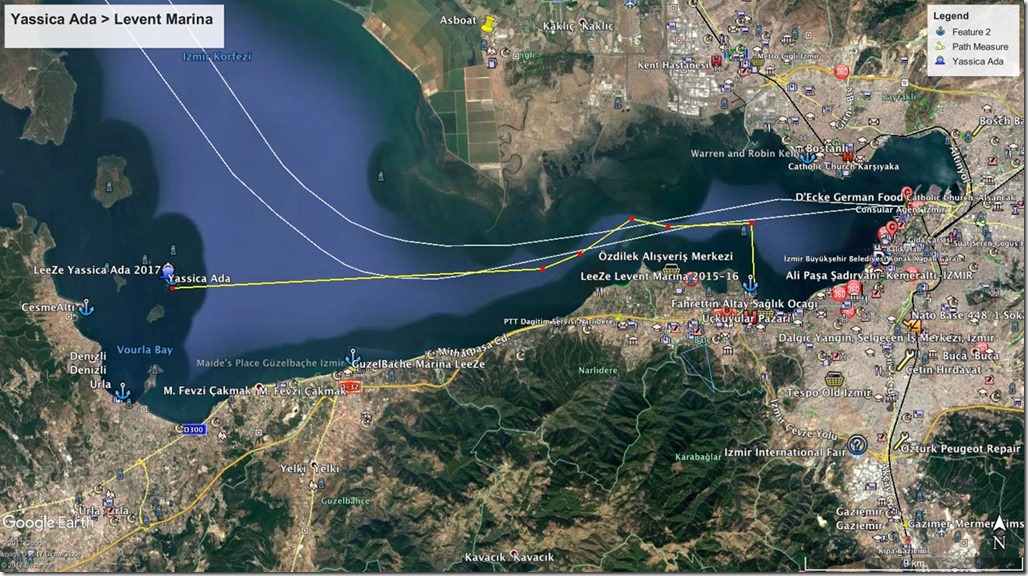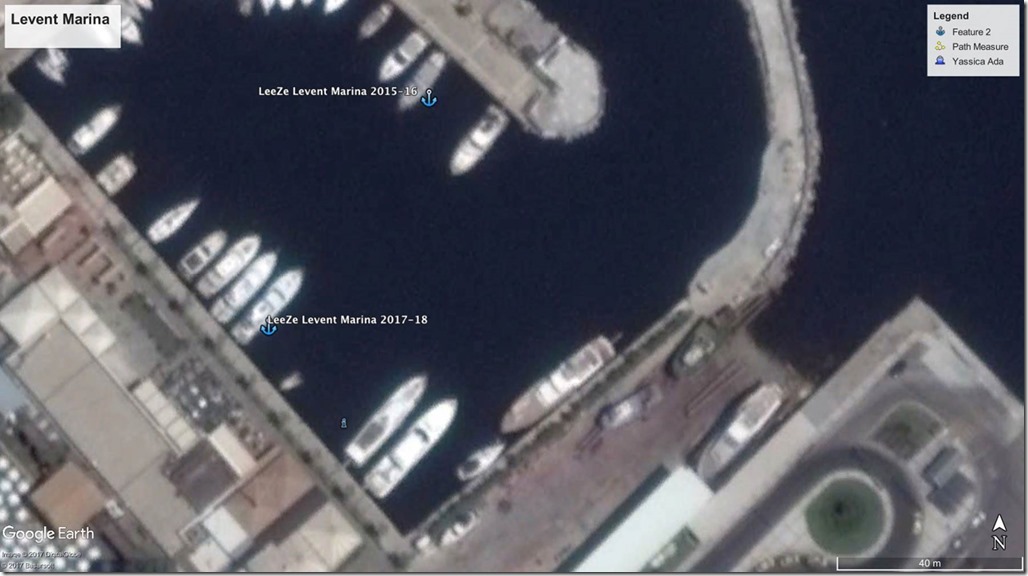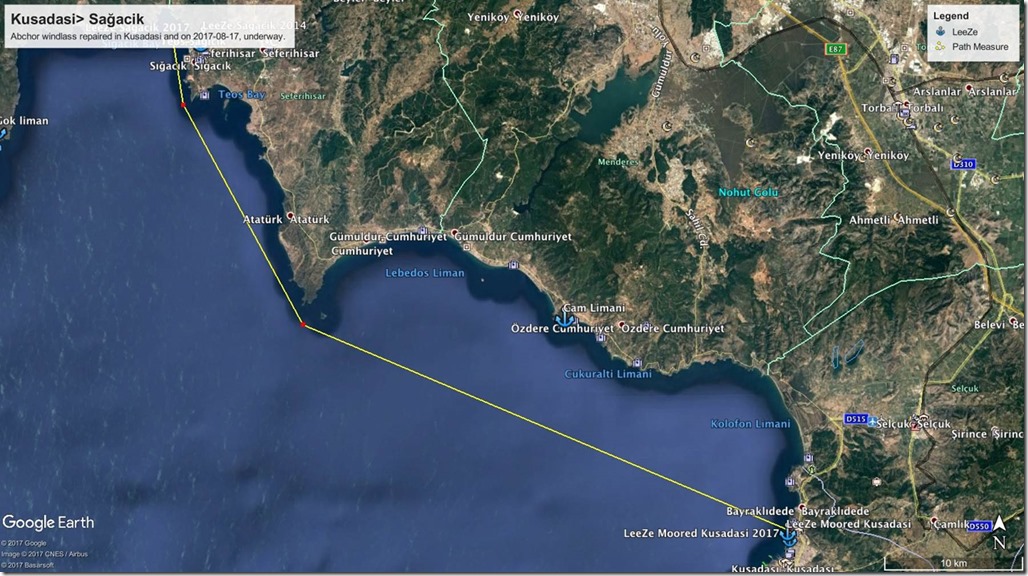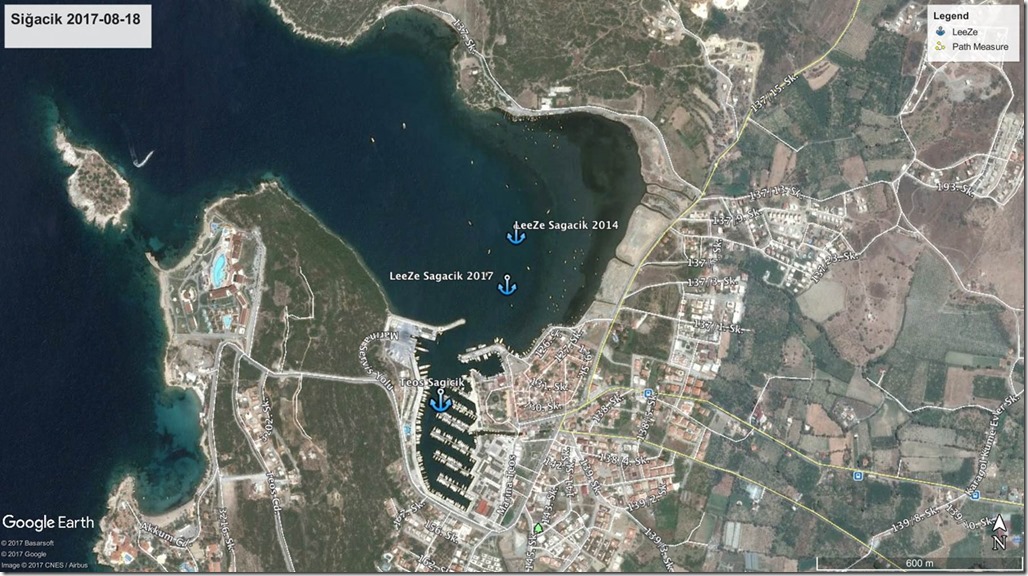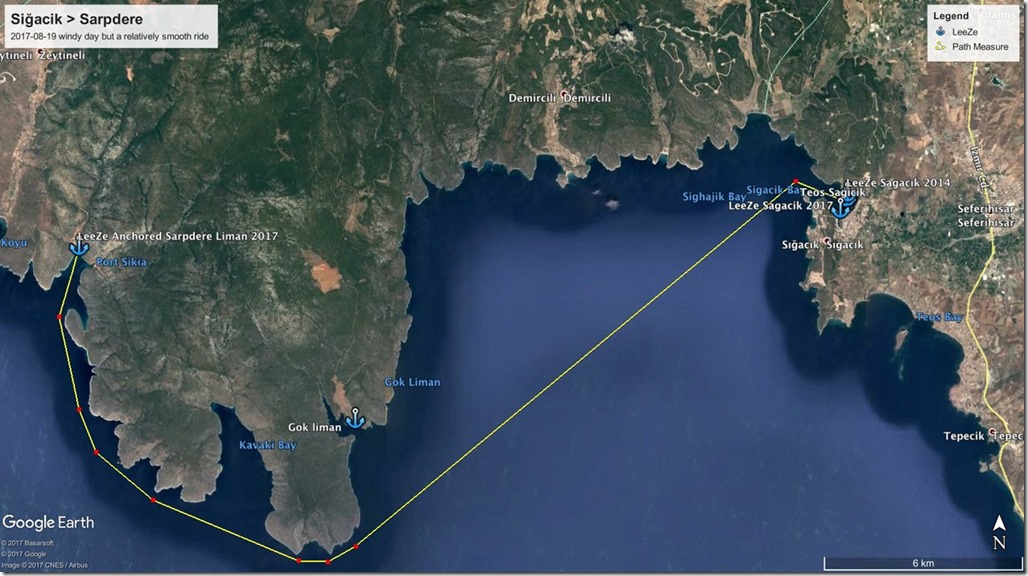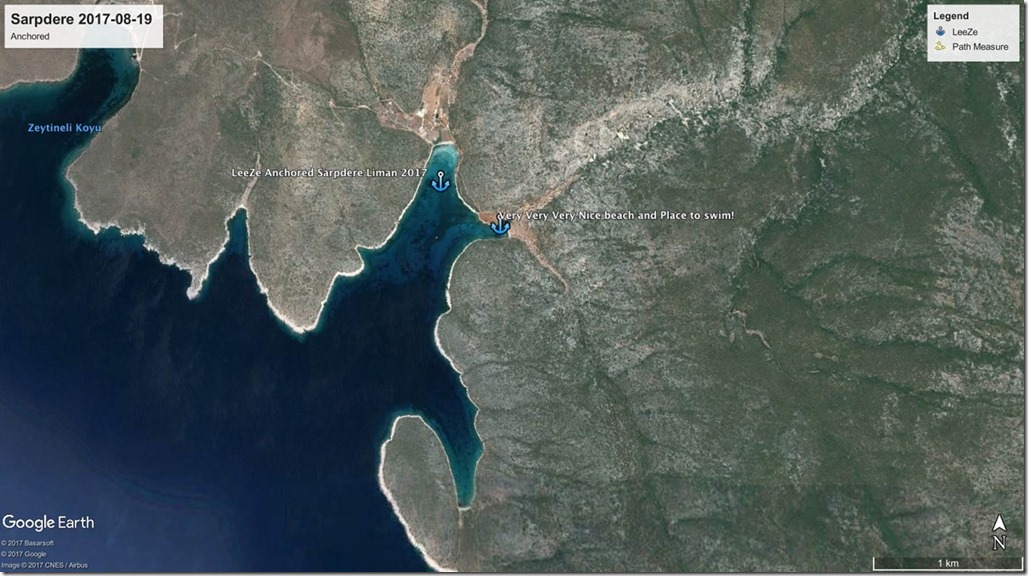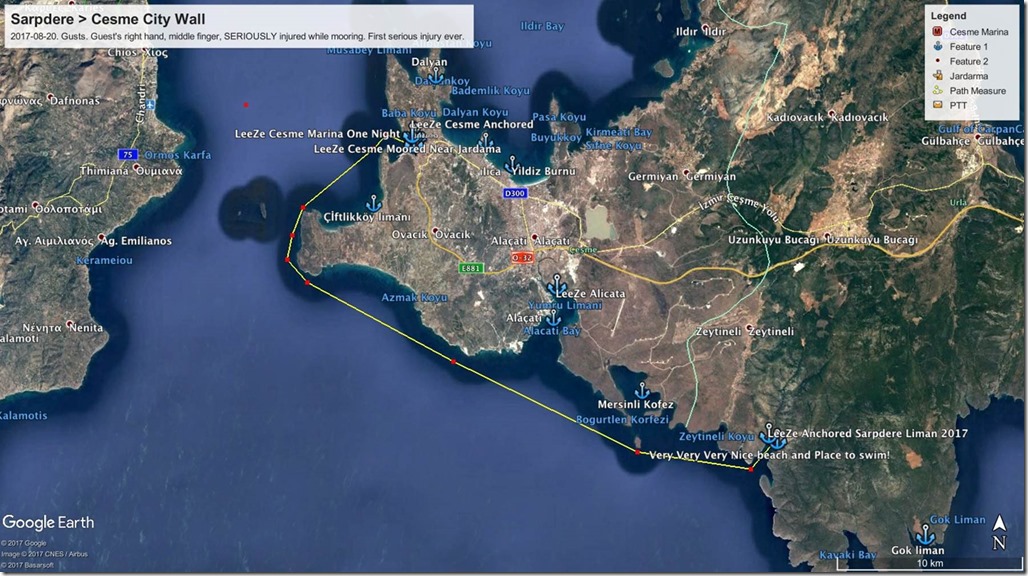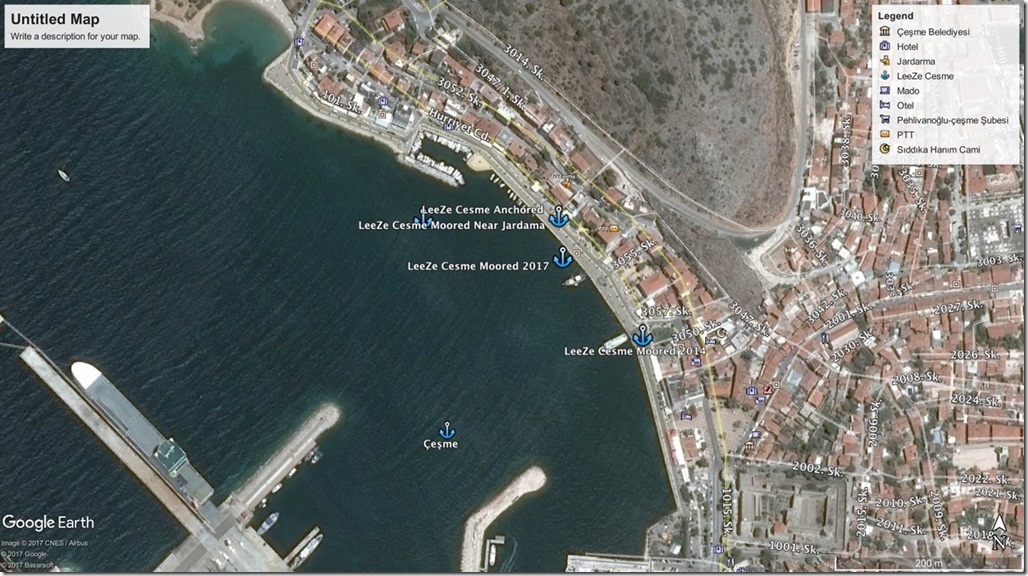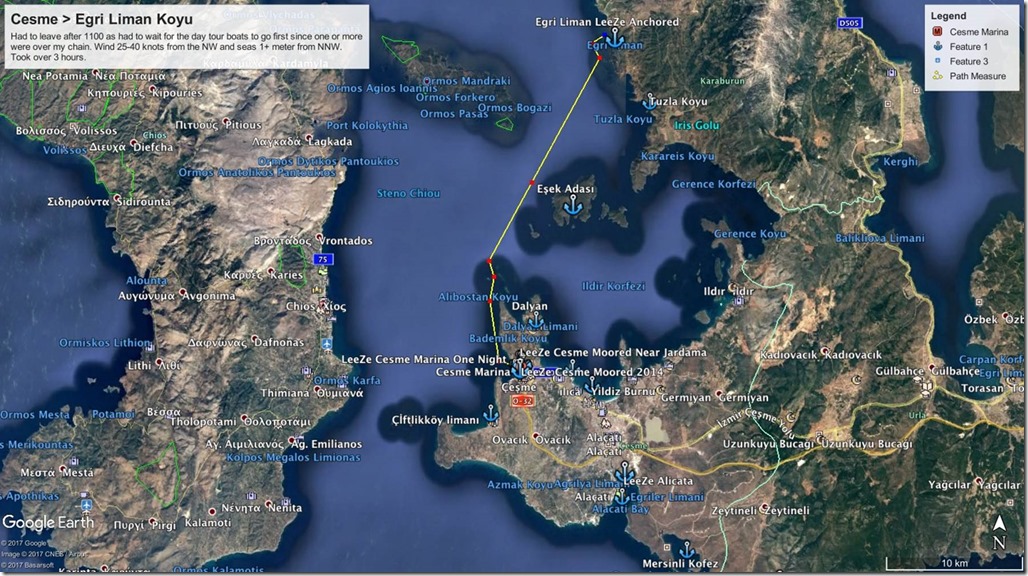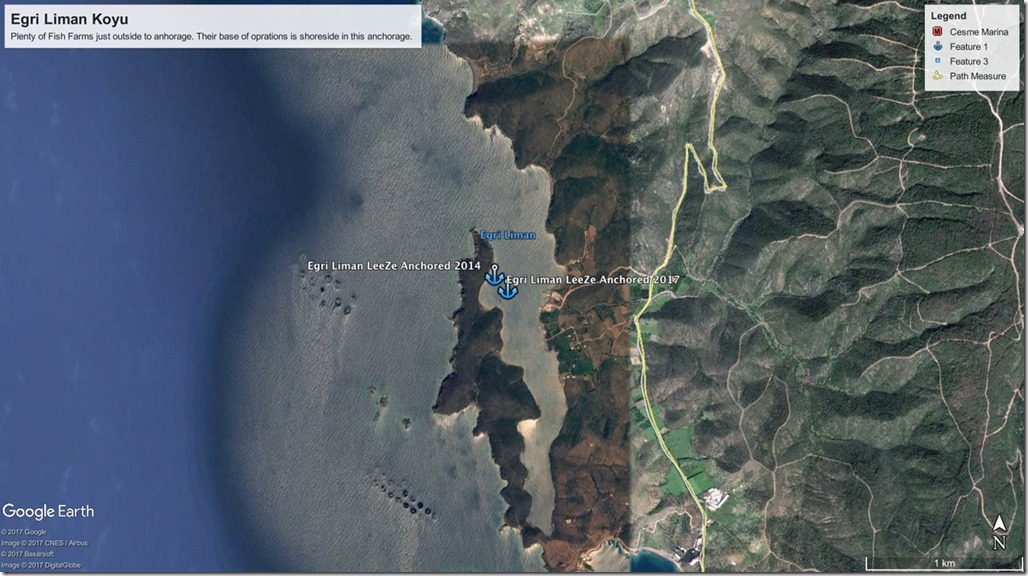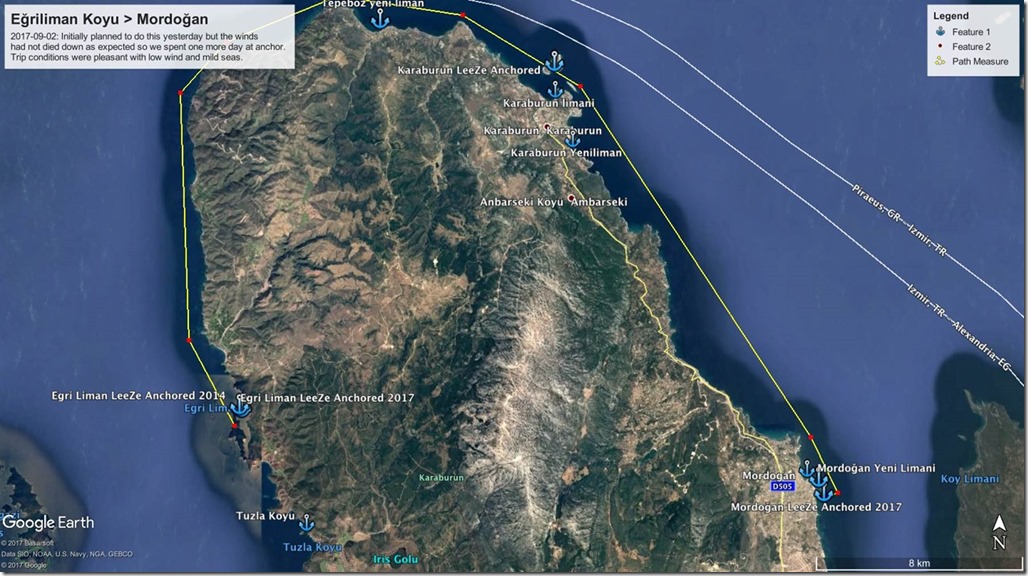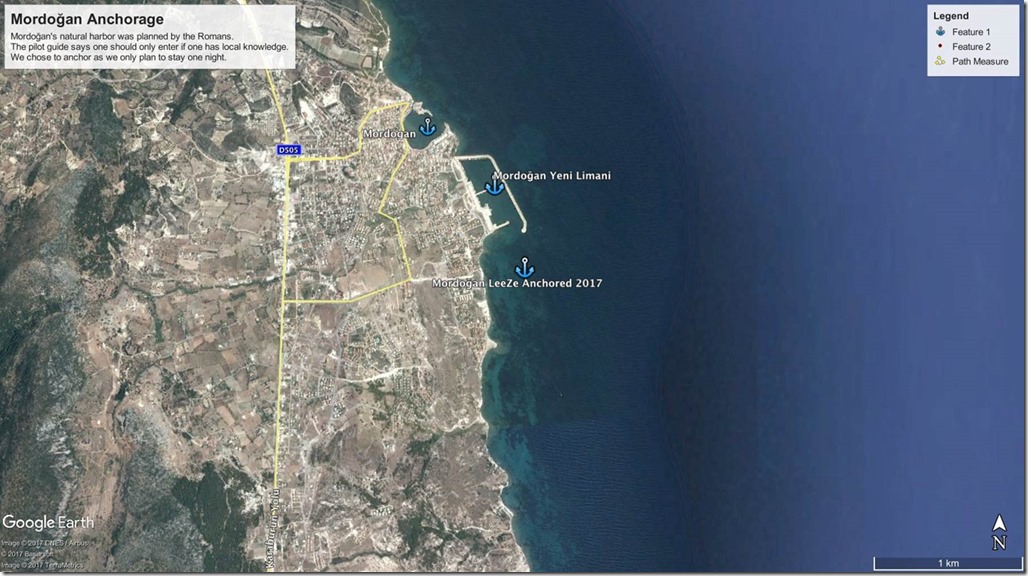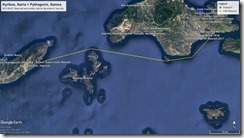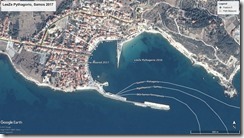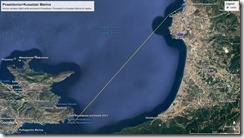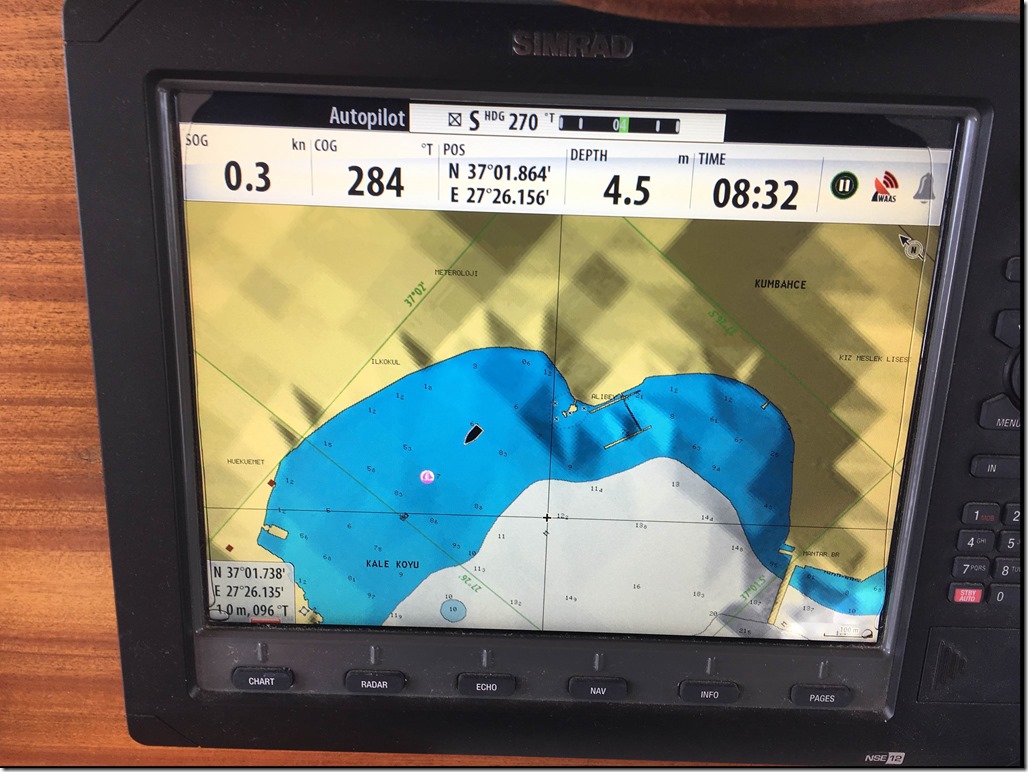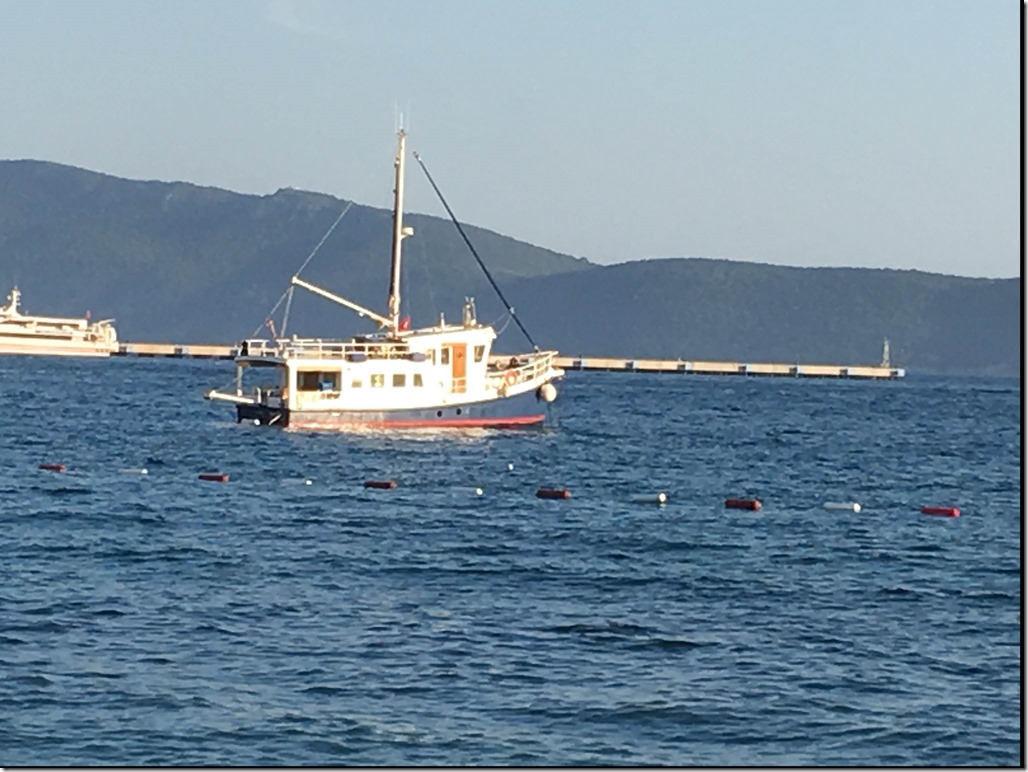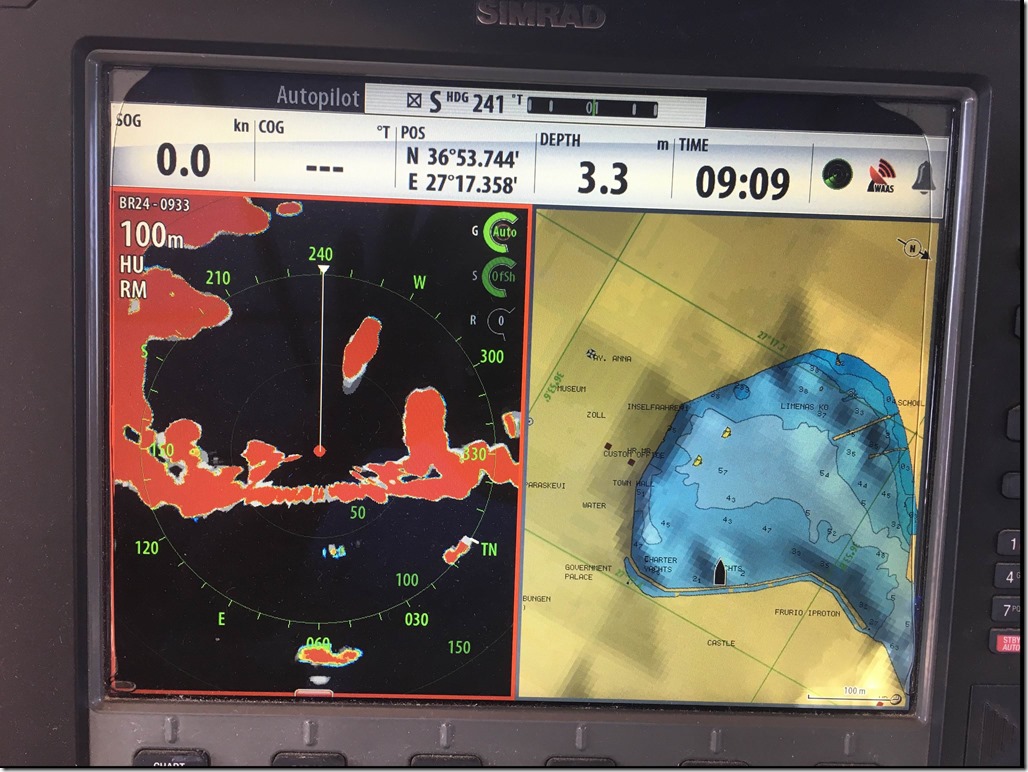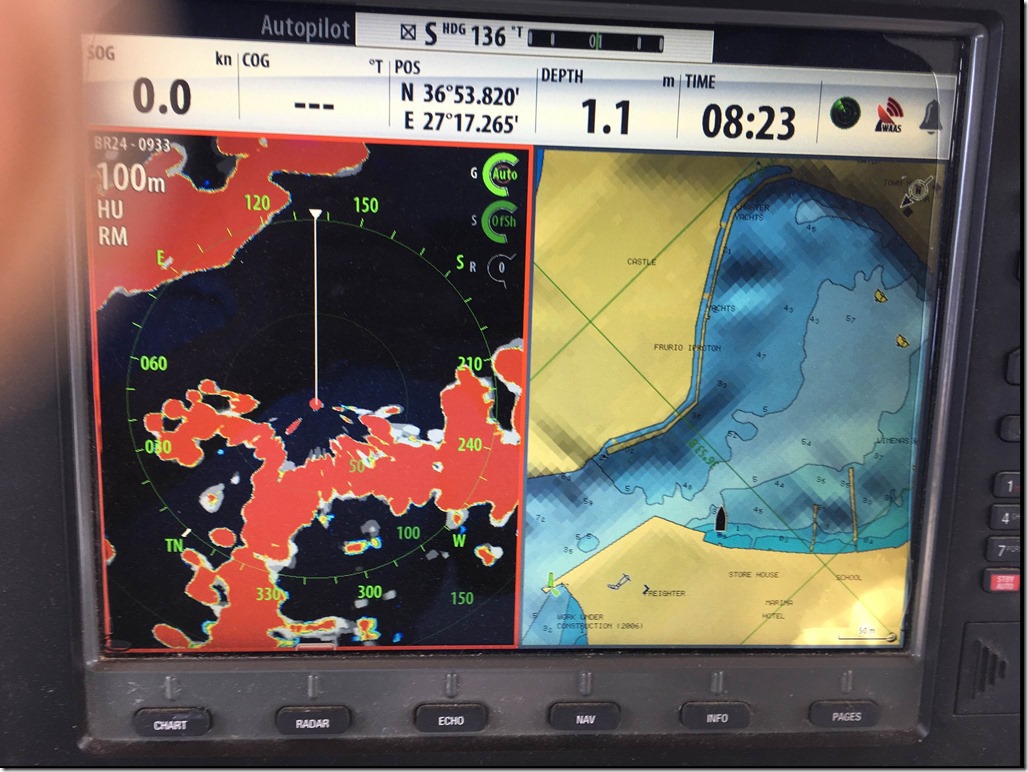2018-12-09
I posted these two emails on New Years’ Eve last year. The process of “med mooring” might put you off buying LeeZe because the process might make you feel that it is way out of your potential boating skills.
Do not allow your mind to go there. If I can make this happen, then I am 100% convinced that with a few practice sessions, you can execute this mooring every time. Your first few efforts may attract undo attention from shore, but as your proficiency increases, the shore audience becomes smaller.
I of course will be there to teach you if you want, or if not close by, support in any way I can.
In the USA, I have never seen a place where boats have to med-moor. I believe this is the same in the Pacific rim area but cannot be certain.
It will take you far longer to read and digest these two emails than it would take to actually execute a med-moor.
The first email that started this exchange is at the bottom of this entry.
Lee A Licata
MV LeeZe
Üçkuyular, Izmir Turkey
+++++++++++++++++++++++++++++++++++++++++++++++++++++++++++++
On Sun, Dec 31, 2017 at 1:24 AM, LAL wrote:
Cedric,
Merry Christmas and Happy New Year.
What you saw was is called “med mooring” and I have only been in a handful of places in 7 years where I did not moor like this, but moored “side-to.”
The lines to the bow have a different name in every country that one visits but they all work the same. The generic name for these lines seems to be “lazy” lines but the term is not universal. In all cases, these lines sink. If there are truly manila lines, they last for years, they sink really really quick so fouling is NOT an issue, and they are marina supplied, usually. I had been to two marinas where the manila lines were purposely too short and those marinas required me to provide my lines to use their short lines.
There is usually huge anchor chain on the marina’s seabed and usually, manila lines (20-30 mm diameter ) are attached to it via a shackle. Some places that cannot afford this chain sink concrete blocks, but these deteriorate over the years requiring a new one be dropped. Pretty soon, it becomes a no-anchoring zone as the blocks can foul your anchor. The old blocks are never retrieved as that costs a lot.
Near to the end of the manila line is a very thin but also sinkable line that is attached to the bitter end of the manila line and the brought to a cleat on the dock.
Now here is where things get complicated, especially if there are only two people on board. (I chose not to address how a single handler would do this mooring.)
Some places, using an assist tender, will hand you the manila / thin line as one is med mooring with the hope that the person receiving the manila line can take the slack out and tie it off to a bow cleat tight. This takes a strain on the line.
The problem with the above is one, the person taking the manila line has to have the strength, speed and dexterity to do that work while the Captain is med mooring.
Now, if the boat is manned by two people, and the Captain is not mooring from an aft cockpit, then the line handler is preoccupied with getting the manila line aboard and tight, while the ship driver not only has to bring the boat astern, but also has to not hit his neighbors too hard and not hit the wall.
So, if done as described above, it makes the mooring process usually more excitable than it needs to.
The other way is that the Captain med moors the boat, gets stern lines ashore and tied off (if one is thinking about this in advance, the line ashore should be long enough so that thy come back aboard so the Captain can adjust lines as needed, the lines are doubled for added strength and shock absorbency, and no assistance from shore is needed when departing). Then, a dock worker hands your crew the thin line (while it is still attached to the cleat), the crew walks forward toward the bow hand over handing the thin line until the bitter end of the manila line appears, then takes the slack out of that line and takes it to a bow cleat tight.
The upside to this method is that your crew is at the Captain’s beck and call until lines astern are over.
The problem is that unless one has a gorilla on board, the crew can never takes out enough slack on the manila line to keep the stern off the dock wall in an appreciable weather.
So, if one uses the first method, and the weather is calm and nice, one person can get the manila line tied off, and then as the boat med moors, the line becomes quite tight and POWER is applied to get the stern lines over and fastened.
If one uses the second method, then the Captain has to handle the boat keeping it off the wall until the stern lines are over, then slack the lines, move forward in the berth with the manila line is brought aboard and tied off, then come back and apply POWER to take the slack out of the manila line while taking in the slack on the astern lines
If the manila line is too tight, then the crew has to release some of the line under load just enough to get closer to the wall but not hit the wall, all the time ensuring that one keeps their 10 fingers and toes. If one releases too much, then the stern can “touch” the wall. If one does not release enough, then there is a do-over.
If the stern lines are doubled and really long, then the captain can come forward in the berth, take the slack off the manila line, the crew can safely “slip” some amount of the line, and then the Captain can come astern.
If the Captain is in a pilot house, or in a center cockpit of a sailboat, things get more complicated if there are only two aboard. The crew is running around like a chicken without its head, trying to do all of the above.
So, you wonder how the hell do we do it.
If there is no assist boat, I ask where their “lazy line mooring chain” is with respect to the dock, and then I drop my anchor 30-50 meters on the far side of the chain and come in, picking up the manila lines after our stern lines are over. Little excitement here but this DOES REQUIRE that the marina understands your question about where the mooring chain is and grants you permission to drop your anchor on the far side. I can only do this when I am mooring to the outside of a wall. If mooring inside the wall or in a U shaped marina, this dos not work.
If this is the case, then I have learned to become quite patient and anchor out until the wind and seas have substantially subsided before mooring.
If these is an assist boat, we INVITE the helmsman on board to handle the manila line. If one does this, one gives up the luxury of the assist boat pushing you around to help you moor, unless there happens to be two people in the assist boat. That only happens when we are mooring at a very pricy ($$$) marina.
If there is no assist boat and the marina is enclosed or “u” shaped, the for sure we wait for calm weather before mooring. Then, after the manila lines are tied off, I use the capstan to take the slack out of the manila lines.
In nearly all med mooring cases, the dock master will insist that one POWERS up the engines taking a strain on the manila lines to make sure they are holding before concluding that you are safely in.
In my last 3-4 med moorings, the dock master had me power up to 2000 rpm astern for some 10-15 seconds to verify holding. This for me, is a huge pucker factor of a moment.
Most of the boats you saw have crew, so this process is far more of a elegant ballet than a cluster f__k but if one watches a bare boat charter do the ballet, one can see more of a CF and less of a ballet.
This email took me more time to write than to perform the actual mooring………
Any questions? Be glad to answer them.
For your info, it took us 3+ years to learn how to med moor without attracting undo attention☺
Lee
Izmir, Turkey
++++++++++++++++++++++++++++++++++++++++++++++++++++++++++++++++++
Cedric,
If the marina is quite crowded, and there is just inches between you and your neighbors, the process is actually less nail biting for a number of reasons:
The Captain ONLY has to get the stern between his neighbors and then gently reverses to get into the slip. It is like bumper pool.
The first mate can usually grab the neighbor’s handrails to hold one in place, but only if one is at dead slow.
Nearly always your neighbors are up and about to assist.
If necessary, you can ask if you can tie off a bow line from you to your neighbor while you work on the lazy line.
And, lastly, if it is a tight fit, one can get closer to the wall by just taking in the stern lines by hand, making a crash with the wall less likely.
Only in one marina, Kemer, Turkey, did I have to lift my fenders out of the way because with them in position, I would NOT have fit.
Cedic, where it becomes hairy is a place like Symi, Greece. No lazy lines here yet, and if and when they come, I will decide to anchor out. If you arrive in the morning when the wind is quite low, usually, there is no room at the wall because no one has left, yet.
The ones that do leave tend to leave between 1100 -1300 and by then, the wind is starting to pick up. Due to the nearby mountains, it roars down to the port toward the sea, usually above 20 knots
The harbor is quite narrow in places, and one needs to drop 70-80 meters + of chain because the bottom is deep and slopes up quickly toward the wall.
So, what we have done is drop 80 meters of chain (leaving 50 for reserve) and motor back, trying to get in before 1000. We once DID get in at 1500 with a 45 knot cross wind and between two french catamarans (rented so from experience we know they carry maybe 50-60 meters of chain, which means that they are not being held off the wall by a strong anchor moor). We had people on the cats to help but in the wind, one has to line up your stern on the nose of the up-wind boat in order to allow for you to slip in between the boats. This of course gives your neighbor a big scare and there is a lot of frantic yelling and waving of hands etc etc etc. Admiral use to get upset by this but knows now what will happen so she just gives them all her Queen Eliz II hand wave.
Once the anchor has grabbed, if you placed it correctly, the stern will naturally slip downwind and when it does, some power will get you in between the boats. Usually by the, the neighbors had either collapsed, been taken to the hospital for suffering a heart attack, or has calmed down.
If one is patient and waits for the wind to die down and for an opening to come available, one waits around the corner in a bay the Brits call “Teflon Bay” because it takes 5-6 times to get one’s anchor to hold. This bay is also where a HUGE water ship comes in every other day to fill the island’s reservoir. He med moors quite gracefully and I learned after he left that his “lane” has been cleared of every patch of weed, grass and rocks for at least 300 meters off the wall some 20 meters wide.
Now, in Symi, as well as a few other places, if one is NOT leaving, you have to be on board at the bow if you came in after your neighbors and they are leaving before you. Fouled anchors is a daily event, and usually quite entertaining, because MOST are renters, have not had to deal with a fouled anchor before, and are leaving when the wind is picking up so they can go sailing, not realizing that first they have to get clear of the wall.
Being a steel boat and not a “plastic” one means I do not care if they hit me, but if they do, I will not use ANY body part to keep them off of me, because I do not want the medical attention.
Also, my chain is 12mm by 130 m with an 88 kg anchor, all worked by a 3 kw anchor windlass with a wildcat. Most of these charters have flimsy windlasses which cannot lift my chain, let alone my anchor. But IF my chain is over theirs, then I am obliged to help, which necessities me getting into my tender with my pole and some line to assist them at their bow in getting untangled.
If we are able to communicate and if they keep their heads, I need only about 10 minutes to free them.
If they are hostile, belligerent, or just plain nasty, I leave them to their own devices until the harbor master comes by and together, we go out to get them untangle. He has the power to shut them up, fine them, make them return to the dock, and seize their boat soooooooo they usually cooperate.
If I am leaving and tangled, my windlass is not even breathing hard in getting their chain up to by bow, but the Captain has to let out chain or rope so that I have some slack to get my chain up without pulling up his anchor. If the Captain is not there, or, more likely, does not have enough chain in the locker to let out, then if they are nice, I will pick up their anchor, clear my chain, stow my anchor, and then while the Admiral slowly goes forward, I walk their anchor back toward the stern and drop it.
If they are not nice, I clear my chain and drop their’s immediately, which usually necessitates them getting underway to reset their anchor.
I learned this all by watching others, talking with professional charter captains, other captains and harbor masters.
Most harbor masters keep a list of which boats they will not allow to moor at their dock. Being naughty gets you on this list.
If a storm is coming, being steel, 50 tons, and anchored well, harbor masters like me because they can usually tie off a bunch of boats to me to keep them more protected from the winds. In one case, in Thassos, Greece, I had 4 stern lines out doubled, two mid-ship breast lines to the wall, and on port and starboard, doubled bow lines running to the wall. The winds were expected to peak above 70 knots, with 50-60 sustained predicted. My bow was tied off to two 25 meter “plastic” yachts on either side because they had such a high freeboard, they knew they were going to be knocked about a lot. In this particular case I took a long line from my bow to a fishing trawler trawler off to starboard to help keep my bow into the predicted direction of the wind, and to help stabilize the rats’ nest that I was in. In turn, I helped him from banging too much into the wall. (Yes, real fishing trawlers are always side too, never med moor, and have priority over us recreational boaters. Only cruise ships and warships out rank them.)
(I must carry more than 1000 meters of 16, 18, 22, and 26 mm rope, in total, plus small stuff.)
Never a dull moment around here.
And I have yet to talk about how does on anchor in a place like Mykonos, when the harbor is full of private mooring buoys, one needs to anchor between them and the $$$$$$$$$$$ yachts tied to them, and close to shore because the depth is mostly >>20 meters. And, the harbor is so crowed that when the wind shifts, if done right, you will swing past your neighbor with meters to spare. Oh and for a guy like me, I refuse to go to the wall because the charge can be 100+ dollars a night, plus line handling fees and security fees.
Even with all of the above, there are tens of thousands that charter here each sailing season med mooring so it is a skill that everyone can learn.………
Lee
Levent Marina, Izmir Turkey
+++++++++++++++++++++++++++++++++++++++++
On Sat, Dec 30, 2017 at 10:26 PM, Cedric Walker wrote:
Lee,
I’ve followed your interesting postings on T&T for years, and I hope I can impose on you to answer a question that seems (to me) a bit beyond the “general interest” mission of T&T.
We were in Palma de Mallorca recently on vacation. I noted that all the the boats in the harbor were tied stern-to-dock, and they all had two (identical) lines running from the bow, down into the water, all at about the same angle. And none had their anchors deployed. And there were no visible mooring balls.
In your travels around the Mediterranean, have you seen an arrangement like this? Were these permanent bow ties, supplied by the marina? How in the heck did the skippers pick them up, without fouling, as they backed into the narrow slit between two other boats?
I can figure out the process for a stern tie-up when an anchor goes in front, and I could do it. But this has me stumped. I’ve got to be overlooking the obvious answer, and I’m hoping that you’ll take a minute to help me out. My wife wants to charter a trawler in the Med, but right now I’m feeling too stupid to try it.
++++++++++++++++++++++++++++++++++++++
On Thu, Jan 11, 2018 at 6:26 PM, Cedric Walker wrote:
THANK YOU! Your answer is wonderfully complete. You should consider publishing it on T&T. This sounds like it’s a white-knuckle process in a crowded marina, and I’m re-thinking the bareboat charter idea.
Our Great Harbour N37 (same as Joe Pica’s) is a wallowing pig in reverse because the bottom is essentially flat. I’ve wondered why there aren’t any in the Med. Now I know the answer.
Thanks again for taking the time to respond so thoughtfully and thoroughly, and best wishes for 2018.
| Cedric F. Walker Ph.D. P.E.
| Professor Emeritus, Department of Biomedical Engineering
| Project Director, Tulane MakerSpace
| Tulane University
| New Orleans LA 70118
